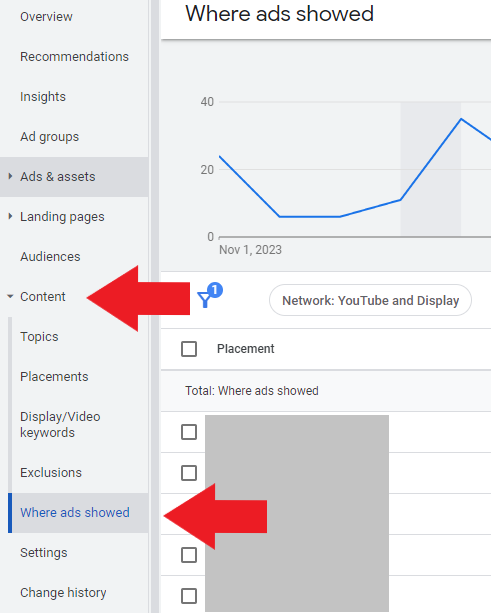A recent study published by Adalytics reports Google Search Partners ads appeared on content that doesn’t adhere to its publisher policies.
Per Google’s Publisher Policies, ads are not permitted to serve alongside content that:
- Is illegal or promotes illegal activity
- Infringes copyright
- Sells or facilitates the sale of counterfeit products
- Incites hatred or promotes discrimination against individuals or a group of people
- Misrepresents, misstates, or conceals information about the publisher
- Makes demonstrably false claims
- And more.
The report found examples of search ads on far-leaning political websites despite advertisers’ attempts to add those domains to a block list.
The report raises questions about the lack of transparency and brand safety concerns for advertisers.
What is the Google Search Partner network?
Per definition, the Google Search Partner Network (GSP) is:
A group of search-related websites and apps where your ads can appear.
The GSP network is not new to Google Ads.
It was established in 2003 to expand its reach beyond the Google search engine.
While Google has never published a complete list of websites that belong to the partner network, the Adalytics report found over 51,000 websites that contained the Google Custom Search engine JavaScript enabled.
This infers that websites with that particular JavaScript are part of the GSP network.
For new Google Search campaigns, they’re automatically opted into the 3rd-party network.
Advertisers can opt out in the campaign settings.
Digging into the compromising placement report
In the Adalytics report, there are multiple examples from advertisers where they found their ads on questionable websites.
 Image credit: Adalytics.io/blog/search-partners-transparency
Image credit: Adalytics.io/blog/search-partners-transparencyThe advertisers reported that they had previously blocked their ads from these websites.
If that is the case, this could mean that the “excluded placements” setting in Google Ads is not working as intended.
The report focused primarily on finding websites on the GSP that seem not to meet Google Publisher Policy terms and conditions, including:
- Pornographic websites
- Websites with copyright-violating material
- Websites where its operators are located in countries where U.S. sanctions may apply.
Additionally, findings included that Google search ads paid for by the U.S. Treasury appeared on companies’ websites in countries including Iran and Russia.
This is important because those countries, including the Iranian Allow Steel Company (IASCO), are under specific sanctions.
Ethical and transparency concerns
The thought-provoking report raises many concerns over the ability to trust Google.
The GSP is known to be a “black box” for advertisers because there is no transparency about who is allowed into the GSP.
Further, if Google wants to make strides in rebuilding trust with advertisers and the public in general, this report certainly puts that trust at risk.
When it comes to advertising, every dollar counts in today’s economy.
When marketers can’t trust where their ads are being shown, they could be privy to moving their dollars to other platforms.
In an X (formerly Twitter) thread, Dan Taylor, Vice President of Global Ads at Google, responded to the allegations in the report:
Adalytics has established a track record of publishing inaccurate reports that misrepresent Google’s products and make wildly exaggerated claims. 🧵
— Dan Taylor (@edantaylor) November 28, 2023
Google has been in the headlines, along with other tech giants, for antitrust lawsuits in the past few years.
What can advertisers do?
There are multiple ways advertisers can proactively combat ads shown on questionable content.
#1: Opt-out of Google Search Partner network on Search campaigns
Since this setting is at the campaign level, advertisers must manually go into each Search campaign to opt out of the GSP.
After navigating to your Search campaign, click “Settings” in the left-hand menu.

Uncheck the “Include Google search partners” box to opt out of the GSP.
#2: Review content suitability settings at the account level
It’s important to note that this setting applies to campaigns running on YouTube or Display.
Navigate to “Tools and settings >> Setup >> Content suitability”
Choose from:
- Expanded inventory
- Standard inventory
- Limited inventory

If you’re concerned about brand safety, it’s wise to choose “Limited inventory,” which has the most safeguards.
#3: Review where ads showed in Display campaigns
While Google won’t show details on where specific Search ads are shown on the 3rd-party network, your Display performance can help guide you.
To check placements on Display campaigns, navigate to a particular Display campaign.
On the left-hand menu, go to: “Content >> Where ads showed”

This report shows what domains your ads showed on.
If there are any questionable or poor-performing websites or apps, you can negate them at the campaign or account level.
Since we’re talking about garnering control over Search ads, you should negate these at the account level.
#4: Use advanced settings to negate additional content exclusions
These advanced settings are in the same spot as “content suitability.”

Here, you can exclude content types, including:
- Sensitive content
- Types and labels
- Themes
- Keywords
- Websites
- Apps
- YouTube channels or videos
If you’ve found questionable placements in Display campaigns, you can negate them at the account level instead of adding them to every campaign.
You can read the full Adalytics report here.
Featured Image: Krakenimages.com/Shutterstock





![AI Overviews: We Reverse-Engineered Them So You Don't Have To [+ What You Need To Do Next]](https://www.searchenginejournal.com/wp-content/uploads/2025/04/sidebar1x-455.png)